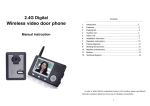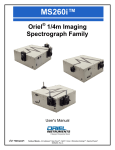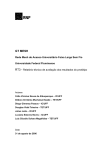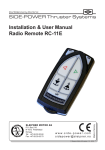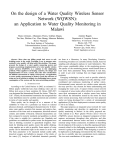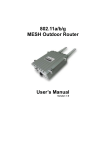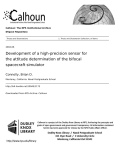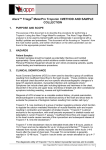Download universiti teknologi malaysia
Transcript
UNIVERSITI TEKNOLOGI MALAYSIA DECLARATION OF THESIS / UNDERGRADUATE PROJECT PAPER AND COPYRIGHT Author’s full name : HAWA DIYANA SAIM Date of birth : 15TH MAY 1985 Title : WIRELESS MESH ROUTING FOR TELEMEDICINE SYSTEM Academic Session: 2007/2008 I declare that this thesis is classified as : √ CONFIDENTIAL (Contains confidential information under the Official Secret Act 1972)* RESTRICTED (Contains restricted information as specified by the organisation where research was done)* OPEN ACCESS I agree that my thesis to be published as online open access (full text) I acknowledged that Universiti Teknologi Malaysia reserves the right as follows : 1. The thesis is the property of Universiti Teknologi Malaysia. 2. The Library of Universiti Teknologi Malaysia has the right to make copies for the purpose of research only. 3. The Library has the right to make copies of the thesis for academic exchange. Certified by : SIGNATURE 850515-14-6414 (NEW IC NO. /PASSPORT NO.) Date : 12TH MAY 2008 NOTES : * SIGNATURE OF SUPERVISOR DR. EKO SUPRIYANTO NAME OF SUPERVISOR Date : 12TH MAY 2008 If the thesis is CONFIDENTIAL or RESTRICTED, please attach with the letter from the organisation with period and reasons for confidentiality or restriction. “I hereby declare that I have read this thesis and in my opinion this thesis is sufficient in terms of scope and quality for the purpose of awarding a Bachelor’s Degree of Electrical Engineering (Electronic).” Signature: ……………………………… Name of Supervisor: Dr. Eko Supriyanto Date: ………………………………… WIRELESS MESH ROUTING FOR TELEMEDICINE SYSTEM HAWA DIYANA BINTI SAIM Submitted to the Faculty of Electrical Engineering in partial fulfillment of the requirement for the degree of Bachelor in Electrical Engineering (Electronics) Faculty of Electrical Engineering Universiti Teknologi Malaysia MAY 2008 ii “I hereby declare that this work as the product of my own effort with the exception of excerpts cited from other works of which the sources were duly noted.” Signature: ………………………… Author’s Name: Hawa Diyana Saim Date: ……………………………… iii ACKNOWLEDGEMENT First of all, I would like to express my gratitude to my supervisor, Dr. Eko Supriyanto for all the guidance he has given me throughout the whole project. My family’s support and assistance are truly appreciated because without them, I might have not made it this far. Thank you so much. Not forgetting my friends who were with me through the ups and downs of this whole project. I hope I helped you as much as you helped me. iv ABSTRACT In rural areas the penetration of telecommunication services, for example telephony and internet access, is low and in some regions non-existent. The telecommunication operators consider rural area as uneconomical due to the nature of these regions - remote, often inaccessible, lacking in infrastructure, sparsely populated, low income households and people with low skills levels. Therefore, it is very difficult to monitor the inhabitants of these rural areas especially if they are suffering from medical conditions. By using the Linksys WRT54GL router which works in the 2.4 GHz frequency band and with wireless mesh routing programmed into the router, patients can be monitored at all times, regardless of their distance from the health centers. The patient’s health data can be monitored with a physiological monitoring system that has been tested to work the wireless mesh router designed. It is basically about overcoming distance and improving access to healthcare. v ABSTRAK Di kawasan pedalaman, penerobosan servis telekomunikasi seperti telefon dan internet adalah kurang memuaskan dan di setengah kawasan, tiada langsung. Operator telekomunikasi melihat kawasan pedalaman sebagai kawasan yang kurang menguntungkan oleh sebab-sebab seperti ia terpencil, sukar untuk didatangi, kurang infrastruktur, kurang penduduk, pendatapan keluarga yang rendah serta penduduk yang kurang mempunyai kemahiran. Oleh itu, ia adalah sangat sukar untuk mengawasi penduduk-penduduk di kawasan pedalaman ini jika mereka meghidap penyakit. Dengan menggunakan router Linksys WRT54GL yang berfungsi pada jalur frekuensi 2.4 GHz dan befungsi dengan protokol “mesh”, pesakit boleh sentiasa diawasi walaupun mereka jauh dari pusat kesihatan atau hospital. Data pesakit boleh dilihat oleh doktor dengan mengunakan satu sistem pengawasan fisiologi yang telah diuji dengan router ini. Ini adalah satu tindakan untuk mengatasi jarak jauh serta memperbaiki sistem kesihatan. vi TABLE OF CONTENTS CHAPTER 1 2 TITLE PAGE DECLARATION OF THESIS i ACKNOWLEDGEMENT ii ABSTRACT iv ABSTRAK v TABLE OF CONTENTS vi LIST OF TABLES viii LIST OF FIGURES ix LIST OF ABBREVIATIONS xi LIST OF APPENDICES xiii INTRODUCTION 1.1 Background 1 1.2 Objective of Project 2 1.3 Scope of Project 3 1.4 Outline of Thesis 3 LITERATURE REVIEW 2.1 Introduction 4 2.1.1 Star Topology 6 2.1.2 Mesh Topology 7 2.1.3 Star-Mesh Topology 9 2.2 Applications of Wireless Networks in Health and 10 Medicine 2.3 Applications of Wireless Mesh Networks 2.3.1 Athens Wireless Network 11 12 vii 2.3.2 Berlin FreiFunk.net 3 4 5 13 2.4 Other Wireless Mesh Router/Modules 13 2.4.1 Crossbow’s MPR 2400 (MICAz) 13 2.4.2 Cirronet’s Wireless Mesh Modules 15 METHODOLOGY 3.0 Introduction 16 3.1 The Linksys WRT54GL 16 3.2 Work Flow and Work Breakdown 19 3.3 Gantt Chart 20 3.4 Design and Implementation 22 3.4.1 Mesh Routing 22 3.4.2 Shortest Path Algorithm 24 3.4.3 Implementing the Algorithm Using PuTTY 28 3.4.4 Main System Settings 31 RESULTS AND DISCUSSION 4.1 Router Configurations 32 4.2 Testing and Integration with Other System 34 CONCLUSION AND RECCOMENDATION 5.1 Conclusion 38 5.2 Recommendation 38 REFERENCES 40 APPENDICES 41 viii LIST OF TABLES TABLE TITLE PAGE 3.0 Specifications of the Linksys WRT54GL 18 3.1 Gantt Chart for PSM1 20 3.2 Gantt Chart for PSM2 21 ix LIST OF FIGURES FIGURE TITLE PAGE 1.0 Scope of Project 3 2.0 Network Cabling is Expensive & Difficult 6 2.1 Star Topology 6 2.2 Mesh Topology 8 2.3 Mesh Networks are Reliable 8 2.4 Installation is a Breeze 9 2.5 Star-Mesh Topology 9 2.6 A Body Sensor 11 2.7 A map of the active nodes in the Athens Wireless Mesh 12 Network 2.8 A partial map of the Berlin wireless mesh network 13 2.9 The MPR 2400 and its Block Diagram 14 2.10 The miniMESH DM1800, miniMESH 1810 and 15 VersaMESH DM2200 3.0 The Linksys WRT54GL (front) 17 3.1 The rear of the Linksys WRT54GL 18 3.2 The Block Diagram of the WRT54GL 19 3.3 Breakdown of Work Done for the Project 19 3.4 MPR Selection 23 3.5 MPR Forwarding (a) Normal Flooding (b) MPR 24 Flooding 3.6 Flowchart of Shortest Path Algorithm 26 3.7 The PuTTY Window 29 3.8 Password Prompt 30 x 3.9 /etc file directory 31 4.0 A Part of the Configuration File of the Router 34 4.1 A Pinging of another Laptop in the Network 35 4.2 A Successful Pinging of the Router 36 4.3 Integration with Physiological Monitoring System 36 4.4 Network Activity 37 xi LIST OF ABBREVIATIONS AES Advanced Encryption Standard BSSID Basic Service Set Identifier CD Compact Disc CTS Clear To Send DHCP Dynamic Host Configuration Protocol DSL Digital Subscriber Line ESSID Extended Service Set Identifier IEEE Institute of Electrical and Electronic Engineer IP Internet Protocol LAN Local Area Network MAC Media Access Control MPR Multi Point Relay OLSR Optimized Link State Protocol OQPSK Offset Quadrature Phase Shift Keying PAN Personal Area Network PC Personal Computer PDA Personal Digital Assistant QoS Quality of Service RF Radio Frequency RTS Request To Send SPI Stateful Packet Inspection SSH Secure Shell TKIP Temporal Key Integrity Protocol VPN Virtual Private Network WEP Wired Equivalent Privacy W-iFi IEEE 802.11 Wireless Standards. Trademark of the Wi-Fi xii Alliance WLAN Wireless Local Area Network WPA WiFi Protected Access WSN Wireless Sensor Network ZigBee IEEE 802.15.4 Standard for Wireless Personal Area Network xiii LIST OF APPENDICES APPENDIX A TITLE The Configuration File for the OLSR Mesh PAGE 41 Protocol B The UDHCPD Configuration File 43 CHAPTER 1 INTRODUCTION 1.1 Background Telemedicine is a rapidly developing field. It is the application of clinical medicine where medical information is transferred via telephone, the internet or other networks. It is most beneficial for populations living in isolated regions and is currently being applied in all medical domains. In a traditional network, routers are used to direct data traffic from one place, or node, to another. Each router has a specific set of locations from which it can accept data, and a specific set of locations to which it can send data. A mesh, or multi-hop network, is a highly decentralized way of organizing nodes that does not require predetermined paths between them. Such networks are made possible by mesh routers, which adjust, in real time, the locations with which they can communicate. Mesh routers work by continuously monitoring network activity and maintaining lists of other devices in their vicinity. When a potential node appears, it broadcasts its address and networking capabilities. Nearby mesh routers will receive the broadcast, and adjust their own lists to reflect the new node. When the device turns off or otherwise disappears, the mesh routers will again update their lists. If a known device broadcasts a request to send data to a specific location, and a router has the receiving node on its list of active devices, it will complete the path and transmit the data. If no individual mesh router can provide a direct path 2 between transmitting and receiving nodes, the data will be sent to another router in the network, and the process repeated until a path can be found. Because mesh routers are continuously adjusting to their environment, the network they create is very robust and highly fault tolerant. With a large enough mesh, it is possible to route around any failed or disappeared router; no mesh router can be a point of failure for the entire network. The drawback of such networks is that without predetermined routing paths, data may take a longer time to reach its destination. Mesh networks are often wireless devices. A mesh router can be as simple as a wireless laptop set to operate in ad hoc mode. In this mode, the laptop acts as the router. There are also dedicated devices that provide greater bandwidth and range. Typically, a dedicated mesh router will not be mobile. Many wireless access points are in fact mesh routers, and can be used to create geographically large wireless networks. 1.2 Objective of Project The main objective of this project is to implement Wireless Mesh Routing using Linksys WRT54GL for Telemedicine System. 1.3 Scope of Project Figure 1.0 shows the big picture of the whole project. However, my project will only focus on the router. As we know, a router is a device that determines the proper path for data to travel between different networks, and forwards data packets to the next device along this path. Therefore, the aim of my project is to make sure that the router works by choosing the shortest and correct path to send the data. The router used for this project is the Linksys 3 WRT54GL. The router must then be tested to show that it can connect to other routers or computers and work in a mesh network. Figure 1.0: Scope of the Project 1.4 Outline of Thesis This thesis consists of five chapters. The first chapter is on the introduction of the project, including its objective and scope. Chapter 2 concentrates on the theory and literature review used for this project. It discusses about wireless mesh routing and its applications. Chapter 3 will be on the methodology of this project. It will also include details on the steps implemented in this project. The results and discussions of this project will be presented in Chapter 4. The conclusion and future recommendations will be discussed in the last chapter, Chapter 5. CHAPTER 2 LITERATURE REVIEW 2.1 Introduction What is a wireless network, you might ask? While the term wireless network may technically be used to refer to any type of computer network that is wireless, the term is most commonly used to refer to a telecommunications network whose interconnections between nodes is implemented without the use of wires, such as a computer network (which is a type of communications network). Wireless telecommunications networks are generally implemented with some type of remote information transmission system that uses electromagnetic waves, such as radio waves, for the carrier and this implementation usually takes place at the physical level or "layer" of the network. Wireless networks have had a significant impact on the world as far back as World War II. Through the use of wireless networks, information could be sent overseas or behind enemy lines easily and quickly and more reliably. Since then wireless networks have continued to develop and its uses have significantly grown. Cellular phones are part of huge wireless network systems. People use these phones daily to communicate with one another. Sending information over seas is possible through wireless network systems using satellites and other signals to communicate across the world. Emergency services such as the police department utilize wireless networks to communicate important information quickly. People and businesses use wireless networks to send and share data quickly whether it be in a small office building or across the world. 5 Another important use for wireless networks is as an inexpensive and rapid way to be connected to the Internet in countries and regions where the telecom infrastructure is poor or there is a lack of resources, like most developing countries. Compatibility issues also arise when dealing with wireless networks. Different components not made by the same company may not work together, or might require extra work to fix compatibility issues. Wireless networks are typically slower than those that are directly connected through an Ethernet cable. A wireless network is more vulnerable because anyone can try to break into a network broadcasting a signal. Many networks offer WEP - Wired Equivalent Privacy - security systems which have been found to be vulnerable to intrusion. Though WEP does block some intruders, the security problems have caused some businesses to stick with wired networks until security can be improved. Another type of security for wireless networks is WPA - Wi-Fi Protected Access. WPA provides more security to wireless networks than a WEP security set up. The use of firewalls will help with security breaches which can help to fix security problems in some wireless networks that are more vulnerable So, why go wireless? Well, there are many reasons why a wireless connection is better than a cabled connection. This can be seen in the Figure 2.0. 6 Figure 2.0: Network Cabling is Expensive & Difficult There are three main topologies of a wireless network. The topologies are: Star Topology Mesh Topology Star-Mesh Topology 2.1.1 Star Topology Figure 2.1: Star Topology 7 Single-hop system in which all nodes/wireless routers are within direct communication range (usually 30 to 100 meters) to a base (monitoring) station All nodes are identical and the base station serves to communicate data and commands to the sensor end points The base station is also used to transmit data to a higher-level control or monitoring system Delivers the lowest overall power consumption, but the transmission distance of the radio limits it in each node An example of an application using a star topology is a medical monitoring PAN (personal area network) in each medical devices measuring patient information such as blood pressure and glucose level can wirelessly transmit the data to the PDA by a doctor performing rounds 2.1.2 Mesh Topology Below are a few key points on mesh topology: Multi-hopping systems in which all wireless sensor nodes are identical and communicate with each other to hop data to and from the sensor nodes and base station Wireless sensors can also pass commands directly to each other in a mesh network, avoiding the need to communicate with each other through a base station Highly fault-tolerant since each sensor node has multiple paths back to the gateway and to other nodes. If a sensor node fails, the network will reconfigure itself around the failed node automatically The multi-hop system allows for much longer range than a star topology, but it has a higher power consumption rate These key points can be understood better by referring to Figures 2.2, 2.3 and 2.4. 8 Figure 2.2: Mesh Topology Figure 2.3: Mesh Networks are Reliable 9 Figure 2.4: Installation is a Breeze 2.1.3 Star-Mesh Topology Figure 2.5: Star-Mesh Topology Seeks to take advantage of the low power and simplicity of the star topology as well as the extended range and self-healing nature of a mesh topology 10 Organize nodes in a star topology around routers and repeaters that in turn organize themselves in a mesh network Routers serve both to extend the range of the network and to provide fault tolerance Offers the highest degree of mobility and flexibility for rapid changes to the network populations and the lowest overall power consumption for networks that need to stretch beyond 30 to 100 meters 2.2 Applications of Wireless Networks in Health & Medicine There are many areas where Wireless Sensor Networks (WSN) can be used in Health & Medicine. The trend of using WSN’s is catching on really quickly. This technology moving forwards progressively as many big names such as Intel are looking into WSN’s as the next generation of mobile telemedicine. Living alone in her quiet home, Harriet often feels lonely and depressed. Newly widowed at 82, she has little interest in physical activity and no zest for social contact. Eating is a chore. She doesn't feel like going out for a meal, and she doesn't feel like fixing food for herself. Consequently, Harriet's health is in serious jeopardy. This combination of social isolation, inactivity and failing nutrition is alarmingly common among today's aging population, but information technology may offer the means to counteract a harmful outcome. Imagine that there's a tiny sensor embedded in one of Harriet's walking shoes and another on the peg where she hangs her outdoor jacket. Whenever these and other miniature sensing devices throughout Harriet's home notice her moving in the direction of her front door, the sensors use a wireless network to alert Sonya, across the street, and Roland, down the block, that Harriet is about to go for a morning walk. Sonya gets the suggestion on her television, and Roland hears it by phone: "Call Harriet now if you want to go along for some exercise." Later the same day, Harriet learns much the same way that cabinet doors are opening in her neighbor Ruth's kitchen. Acting on a verbal cue that she hasn't eaten yet today, Harriet calls Ruth to suggest that they prepare 11 and eat lunch together. The two end up sharing food, activity and conversation. Such technology scenarios may seem far-fetched, even science fiction-like, but they are in fact close to becoming real. The key is wireless sensor networks, an intriguing new technology model in which behavioral and biological data is collected and analyzed for customized proactive computing applications. As the name implies, proactive computing aims to anticipate people's needs and take action to meet those needs on their behalf, relieving people of tedious data entry. Another example is inside an experimental smart home at Intel’s Oregon campus, where a sensor network is under development that could someday keep tabs on an Alzheimer’s patient’s vital signs while reminding him how to warm up his lunch. Body sensors monitor vital signs such as heart and sugar. The sensor is attached to the body like the figure below: Figure 2.6: A Body Sensor 2.3 Applications of Wireless Mesh Networks Mesh networks are becoming ever more popular. This is because it is affordable, easy to manage and trusted. It has been implemented all around the world for many different types of functions. 12 2.3.1 Athens Wireless Network This wireless mesh network is one of the biggest mesh networks there is. It has more than 7000 nodes and usually around 2000 nodes are active. It has 909 backbone nodes and 607 access points. Figure 2.7: A Map of the Active Nodes in the Athens Wireless Mesh Network 13 2.3.2 Berlin FreiFunk.net This wireless mesh network has over 600 nodes. It is also very successful and many other wireless mesh networks have tries to emulate this particular mesh network. Figure 2.8: A Partial Map of the Berlin Wireless Mesh Network 2.4 Other Wireless Mesh Router/Modules In this subtopic, the different types of wireless mesh routers/modules will be discussed. This is done so that the different types of modules can be compared in terms of price, hardware, software, user friendliness and etc. 2.4.1 Crossbow’s MPR 2400 (MICAz) The MICAz is the latest generation of Motes from Crossbow Technology. The MPR2400 (2400 MHz to 2483.5 MHz band) uses the Chipcon CC2420, IEEE 802.15.4 compliant, ZigBee ready radio frequency transceiver integrated with an 14 Atmega128L micro-controller. The same MICA2, 51 pin I/O connector, and serial flash memory is used; all MICA2 application software and sensor boards are compatible with the MPR2400. Figure 2.9: The MPR 2400 and its Block Diagram The radio used by the MPR2600 is an IEEE 802.15.4 compliant RF transceiver designed for low-power and low-voltage wireless applications. It uses Chipcon’s CC2420 radio that employs OQPSK with half sine pulse shaping. The 802.15.4 radio includes a DSSS (digital direct sequence spread spectrum) baseband modem providing a spreading gain of 9 dB and an effective data rate of 250 kbps. The radio is a highly integrated solution for wireless communication in the 2.4 GHz unlicensed ISM band. It complies with worldwide regulations covered by ETSI EN 300 328 and EN 300 440 class 2 (Europe), FCC CFR47 Part 15 (US) and ARIB STD-T66 (Japan). An MPR 2400 costs 99USD which is far more expensive that the Linksys WRT54GL. Therefore it is less economical when using it in a mesh network because a mesh networks needs a lot of modules for it to be more efficient. 15 2.4.2 Cirronet’s Wireless Mesh Modules Cirronet has quite a few wireless mesh modules. It is used in short to medium-range industrial and commercial applications. One of its products is the miniMESH DM1800. It is a single fixed channel RF transceiver operating on either 433.92 MHz or 916.5MHz unlicensed frequencies. It is compatible with many low-current power sources as it operates on only 4mA in receive mode and 13.5mA in peak transmit mode. Its range is about 200meters/hop in an ‘open field’ outdoor environment. Out of all the other mesh nodes we have discussed so far, it is the most affordable as it costs only 25USD per node. Another one of Cirronet’s products is the miniMESH DM1810. It is also a single fixed channel RF transceiver operating on either 433.92 MHz or 916.5MHz unlicensed frequencies. It operates on only 5.5mA in receive mode 28.5mA peak in transmit mode which make sit compatible with many low-current power sources. In an ‘open field’ outdoor environment, its range is 200meters/hop. However, it is a bit more costly than the miniMESH 1800 as it costs 30USD per node. Figure 2.10: The miniMESH DM1800, miniMESH 1810 and VersaMESH DM2200 Other than that, there is also the VersaMESH DM2200. Single digitally modulated channel operating centered on 433.92 MHz and 916.5 MHz unlicensed frequency CHAPTER 3 METHODOLOGY 3.0 Introduction In this project, the hardware that will be used is the Linksys WRT54GL. When bought at the store, the Linksys WRT54GL should come with a power adapter, a LAN cable and a CD which contains the user manual. The CD will not be needed, but the other peripherals are important. 3.1 The Linksys WRT54GL The Linksys WRT54GL Wireless-G Broadband Router combines the functionalities of three devices into a single device, a wireless access point, a fourport full-duplex 10/100 Mbps switch and a router. The wireless access point lets you connect Wireless-G or Wireless-B devices to the network while the switch connects your wired-Ethernet devices together. The router function ties it all together by letting your whole network share a high-speed cable or DSL Internet connection. The push button setup feature makes it easy to configure your wireless devices. The WRT54GL even features TKIP and AES to protect your data and privacy with up to 128-bit encryption. 17 With the Linksys Router at the center of your home or office network, you can share a high-speed Internet connection, files, printers and multi-player games with flexibility, speed, security and simplicity. Status Indicators - Port status, link activity Compliant Standards - FCC IEEE 802.3, IEEE 802.3U, IEEE 802.11b, IEEE 802.11g Data Link Protocol - Ethernet, Fast Ethernet, IEEE 802.11b, IEEE 802.11g Interfaces - 1x network - Ethernet 10Base-T/100Base-TX - RJ-45 ( WAN / DMZ ), 4 x network - Ethernet 10Base-T/100Base-TX - RJ-45, 1 x network - RadioEthernet Dimensions - Height 4.8 cm x Depth 20 cm x Width 18.6 cm Weight - 0.5 kg. Linksys released the WRT54GL in 2005 to support third-party firmware based on Linux, after the original WRT54G line was switched from Linux to VxWorks, starting with version 5. The WRT54GL is technically a reissue of the version 4 WRT54G. The 1.0 version of this model has serial numbers starting with CL7A; version 1.1 models have serial numbers starting with CL7B and CL7C. The cost of a Linksys WRT54GL module is RM220. However, the specifications mentioned above will change once the project gets going. Much of it original functionalities will be changed with the new one that is to be uploaded that will enable it to work as a mesh router. Figure 3.0: The Linksys WRT54GL (front) 18 Figure 3.1: The rear of the Linksys WRT54GL Reset button: There are two ways to reset the router’s factory settings. Either press the reset button and hold for 5 seconds, or by restoring the defaults in the web UI. Internet port: The Internet port is where the Ethernet cable will be connected 1, 2, 3, 4: These ports connect the router to the networked PCs Power: The Power port is where the power adapter is to be connected Table 3.0: Specifications of the Linksys WRT54GL Architecture MIPS Vendor Broadcom CPU Speed 200 MHz RAM 16MB Flash Memory 4MB System-On-Chip Broadcom 5352EKPB Frequency Band 2.4 GHz 19 Figure 3.2: The Block Diagram of the WRT54GL 3.2 Work Flow and Work Breakdown Integration of router with PC Update the Linksys WRT54GL with mesh protocol Implement shortest path Input main system settings such as ESSID, BSSID, Subnet Mask and etc Figure 3.3 Breakdown of Work Done for the Project 3.3 Gantt Chart Table 3.0 Gantt chart for PSM 1 Tasks for PSM1 Meet with lecturer WEEK 1 2 Study of Telemedicine System Study of Wireless Mesh Network Reverse Engineering of Wireless Router Measurements of Power, Signal etc. in a Wireless Router Design of a Wireless Mesh Router Algorithm Design of Mesh Protocol Report Writing Proposed Actual 3 4 5 6 7 8 9 10 11 12 13 14 Table 3.1: Gantt chart for PSM 2 WEEK Tasks for PSM2 1 2 Meet with lecturer Research/ Study on Routers Testing of Router Integration/Installation with PC Implementation of Programming Integration in Wireless Mesh Network Testing and Optimization Report Writing Proposed Actual 3 4 5 6 7 8 9 10 11 12 13 14 22 3.4 Design and Implementation The Linksys WRT54GL is a normal wireless router which can be used as an access point. However, it will not be able to work as a mesh router with its original setting. Changes needed to be made and these included updating it with the mesh protocol as well as the shortest path algorithms. 3.4.1 Mesh Routing There are many ways to implement mesh routing as there are many different types of mesh protocols. For this project, I chose to follow the mesh protocol Optimized Link State Routing Protocol (OLSR). The OLSR is a proactive routing protocol. Every node sends periodically broadcast "Hello"-messages with information to specific nodes in the network to exchange neighbourhood information. The information includes the nodes IP, sequence number and a list of the distance information of the nodes neighbours. After receiving this information a node builds itself a routing table. Now the node can calculate with the shortest path algorithm the route to every node he wants to communicate. When a node receives an information packet with the same sequence number twice he is going to discard it. In these routing tables he stores the information of the route to each node in the network. The information is only updated: a change in the neighbourhood is detected a route to any destination is expired a better (shorter) route is detected for a destination The difference from OLSR to LSR (Links State Protocol) is that OLSR relies on multi-point relays (MPR). MPR is a node which is selected by its direct neighbour (one hop). The first idea of multipoint relays is to minimize the flooding of 23 broadcast messages in the network. An information packet should not be sent twice in the same region of the network. MPR helps to optimize and reduce that problem. Each node informs its direct neighbours (one hop) about its MPR set in the "Hello"messages. After receiving such a "Hello"-message, each node records the nodes MPR Selector that selects it as one of their MPRs. The second idea is that the size of the hello messages is reduced. It includes only the neighbours that select node N2 as one of their MPR nodes. In this way partial topology information is propagated. Node N2 can be reached only from its MPR selectors. Each node in the network, in our example node N2, selected a few neighbour nodes in the network. These nodes will send node N2-packets. These selected nodes, N1 and N6 are called Multipoint Relays of node N2. Node N2 selects its MPR to cover all the nodes that are exactly two hops away from it. In our example: N7, N8, N9 and N4. A node which is not a Multipoint Relay can read the packet sent from N2 but cannot forward it. Figure 3.4 MPR Selection In opposition to normal flooding (Figure 3.5(a)), only Multi point relays can forward the messages (Figure 3.5(b)). 24 (a) (b) Figure 3.5 MPR Forwarding (a) Normal Flooding (b) MPR Flooding Advantages: minimal latency ideal in high density and large networks OLSR achieves more efficiency than classic LS algorithms when networks are dense OLSR avoids the extra work of "finding" the destination by retaining a routing entry for each destination all the time, thus providing low singlepacket transmission latency OLSR can easily be extended to QoS monitoring by including bandwidth and channel quality information in link state entries. Thus, the quality of the path (e.g., bandwidth, delay) is known prior to call setup 3.4.2 Shortest Path Algorithm As discussed in the above subtopic, the mesh routing must implement the shortest path algorithm. For this algorithm, the procedures are as explained below. 1. The router builds a graph of the network and identifies source and destination nodes, as V1 and V2 for example. Then it builds a matrix, called the "adjacency matrix." In this matrix, a coordinate indicates weight. For 25 example, [i, j] is the weight of a link between Vi and Vj. If there is no direct link between Vi and Vj, this weight is identified as "infinity." 2. The router builds a status record set for every node on the network. The record contains three fields: (a) Predecessor field - The first field shows the previous node. (b) Length field - The second field shows the sum of the weights from the source to that node. (c) Label field - The last field shows the status of node. Each node can have one status mode: "permanent" or "tentative." 3. The router initializes the parameters of the status record set (for all nodes) and sets their length to "infinity" and their label to "tentative." 4. The router sets a T-node. For example, if V1 is to be the source T-node, the router changes V1's label to "permanent." When a label changes to "permanent," it never changes again. A T-node is an agent and nothing more. 5. The router updates the status record set for all tentative nodes that are directly linked to the source T-node. 6. The router looks at all of the tentative nodes and chooses the one whose weight to V1 is lowest. That node is then the destination T-node. 7. If this node is not V2 (the intended destination), the router goes back to step 5. 8. If this node is V2, the router extracts its previous node from the status record set and does this until it arrives at V1. This list of nodes shows the best route from V1 to V2. These steps are shown below in a flowchart: 26 Figure 3.6: Flowchart of Shortest Path Algorithm A detailed explanation is as follows: Here we want to find the best route between A and E (see below). You can see that there are six possible routes between A and E (ABE, ACE, ABDE, ACDE, ABDCE, ACDBE), and it's obvious that ABDE is the best route because its weight is the lowest. But life is not always so easy, and there are some complicated cases in which we have to use algorithms to find the best route. As you see in the image below, the source node (A) has been chosen as Tnode, and so its label is permanent (we show permanent nodes with filled circles and T-nodes with the --> symbol). 27 In this step, you see that the status record set of tentative nodes directly linked to T-node (B, C) has been changed. Also, since B has less weight, it has been chosen as T-node and its label has changed to permanent (see below). In this step, like in step 2, the status record set of tentative nodes that have a direct link to T-node (D, E), has been changed. Also, since D has less weight, it has been chosen as T-node and its label has changed to permanent (see below). In this step, we don't have any tentative nodes, so we just identify the next Tnode. Since E has the least weight, it has been chosen as T-node. E is the destination, so we stop here. 28 We are at end. Now we have to identify the route. The previous node of E is D, and the previous node of D is B, and B's previous node is A. So the best route is ABDE. In this case, the total weigh is 4 (1+2+1). 3.4.3 Implementing the Algorithm Using PuTTY PuTTY is an SSH and telnet client, developed originally by Simon Tatham for the Windows platform. PuTTY is open source software that is available with source code and is developed and supported by a group of volunteers. PuTTY is a client program for the SSH, Telnet and Rlogin network protocols. These protocols are all used to run a remote session on a computer, over a network. PuTTY implements the client end of that session: the end at which the session is displayed, rather than the end at which it runs. In really simple terms: you run PuTTY on a Windows machine, and tell it to connect to (for example) a Unix machine. PuTTY opens a window. Then, anything you type into that window is sent straight to the Unix machine, and everything the Unix machine sends back is displayed in the window. So you can work on the Unix machine as if you were sitting at its console, while actually sitting somewhere else. PuTTY does not process the commands you type into it. It's only a communications tool. It makes a connection to another computer; it passes the commands you type to that other computer; and it passes the other computer's responses back to you. Therefore, the precise range of commands you can use will not depend on PuTTY, but on what kind of computer you have connected to and what software is running on it. The PuTTY team cannot help you with that. Think of PuTTY as being a bit like a telephone. If you phone somebody up and you don't know what language to speak to make them understand you, it isn't the telephone company's job to find that out for you. 29 Figure 3.7: The PuTTY Window There are quite a few basic commands that must be understood. If we look at Figure 3.5; we can see that I have entered “[email protected]”. This is because the default gateway of the WRT54GL is 192.168.1.1. By entering the command root, we are directly accessing the WRT54GL. This is because the default username programmed in the Linksys WRT54GL is root. Once we have accessed the Linksys, a prompt for your password will appear. The default password is “admin”, but both the username as well as the password can be changed later on. 30 Figure 3.8: Password Prompt We must now unpack, compile and install the source code of the OLSR algorithm: # tar jxvf uolsrd-x.y.z # od unik-olsrd-x-y.z # make # make install The olsrd gets installed to /usr/bin/ and a default config file can be found under /etc Below you can see that I have changed the directory using the cd /etc command as I want to view the contents of the directory. I then keyed in ls –l loc* to view the files in that directory. 31 Figure 3.9: /etc file directory 3.4.4 Main System Settings For the mesh routing to work properly, many changes and settings need to be made. Check out the /etc/olsrd.conf configuration files. All values in the files is overridden with command line option clsrd. The main options to change are shown below. Setting the “DEBUG” to 0 makes it run in the background. Setting this higher will produce a lot more info messages on forwarding, parsing of the configuration file etc. # Debug level (0-9) # If set to zero the daemon runs in the background DEBUG 1 # IP version to use (4 to 6) IPVERSION 6 # A list of whitespace separated interface names INTERFACES eth1 CHAPTER 4 RESULTS AND DISCUSSION In this chapter of the thesis I will mainly discuss the configurations of the Linksys WRT54GL and why those settings are chosen. I will then show the final outcome of this project. 4.1 Router Configurations Firstly, the most important setting is the WLAN-IP Address. I chose 10.1.1.10 for the router. However, the IP address is chosen according to the RFC 1918. When dealing with IP addresses, the RFC 1918 plays a big part as it dictates what IP address are available and allowed to use for private network. Some IP addresses are locked and can only be used for specific purposes. Next is the WLAN Protocol; where the Static Protocol is chosen. This is because a static WLAN does not automatically change its IP address. It tells the router that all messages with the sender and receiver having an address showing the first three groups of numbers are on the same network. WLAN Mode must be set to ad-hoc as in ad-hoc mode where there is no hierarchical master-client relationship. Routers can communicate directly as long as they are within range of their wireless interfaces. Ad-hoc routers do not repeat by default, but they can effectively do the same if routing is applied. Mesh networks 33 are based on the strategy that every mesh-enabled router acts as a relay to extend the coverage of the wireless network. The ESSID (Network Name) for my project is PSM_MESH and the BSSID ( this is the MAC address of the wireless interface) is 02: ca: ff: ee: ba: be. All routers must have the same BSSID. The BSSID is important to specify to allow rejoining mesh networks should the mesh ever break into at least 2 networks due to a connection going down and later coming back on. Channel is set to 6 and all routers must be on the same channel. Once again, channel allocation must refer to the RFC 1918 as some channels are restricted in some countries. Beacon Interval represents the amount of time between beacon transmissions. Before the router enters power save mode, the router needs the beacon interval to know when to wake up to receive the beacon. After receiving a beacon frame, each router waits for the beacon interval and then sends a beacon if no other router does so after a random time delay. This ensures that at least one station will send a beacon, and the random delay rotates the responsibility for sending beacons. By increasing the beacon interval, you can reduce the number of beacons and associated overhead, but that will likely delay the association and roaming process because stations scanning for available access points may miss the beacons. You can decrease the beacon interval, which increases the rate of beacons. This will make the association and roaming process very responsive; however, the network will incur additional overhead and throughput will go down. As you can see, beacon intervals are very important, after a lot of testing, I found out the most suitable beacon interval for this project would be 100 milliseconds. Fragmentation threshold and RTS threshold are both set to 2346 and 2347 respectively as this is the default setting for all routers. The fragmentation threshold determines the packet size needed to activate the fragmentation of data packet into several fragments. It improves the performances of the wireless mesh network. The 34 RTS threshold will activate the RTS/CTS handshaking mode for secure data transfers in wireless networks. Figure 4.0: A Part of the Configuration File of the Router 4.2 Testing and Integration with Other System For this project, testing had to be done many times. This is because it must work with a physiological monitoring system which is another project conducted by another student. 35 At first, the tests were simple. I simply tested to see if other computers and laptops could connect to the wireless router that has been set up. After that, the testing with the physiological monitoring system began. When computers or laptops were connected to the network, a pinging of the PC/laptop would show if the devices are communicating with each other. Figure 4.1: A Pinging of another Laptop in the Network The figure above shows that the devices in the mesh network are communicating with each other and that data is being sent and received successfully. Figure 4.2 shows a pinging of the router itself. As you can see that the pinging is successful so the router is working as a mesh router. 36 Figure 4.2: A Successful Pinging of the Router After pinging is successful, the wireless router is tested to work with the physiological monitoring system. Tests proved that the wireless mesh routing using the Linksys WRT54GL was able to work with the system. Figure 4.3: Integration with Physiological Monitoring System 37 Monitoring of the wireless network was also done using a networking monitoring software. It shows when there is a lot of activity in the network. A lot of activity is observed when the computers are communicating, i.e. when the physiological system is in process. However, network activity is monotonous when there is nothing going on. This can be seen in the Figure 4.4. Figure 4.4: Network Activity CHAPTER 5 CONCLUSION AND RECCOMENDATION 5.1 Conclusion Mesh networks are different. As long as a node is connected to at least one other node in a mesh network, it will have full connectivity to the entire network because each mesh node forwards packets to other nodes in the network as required. Mesh protocols determine the best route through the network and can dynamically reconfigure the network if a link becomes unusable. After buying a Linksys WRT54GL wireless router, it was successfully updated to work as a mesh router using a mesh protocol as well as the shortest path algorithm using PuTTY. Tests were carried out to find out if the wireless mesh router is working as it should be. However, the most important test was to test the router with a physiological monitoring system. This was successfully done and was presented in the result section. It can be said that wireless mesh routing was successfully implemented using the Linksys WRT54GL router. 5.2 Recommendation Even though the wireless mesh routing using the Linksys WRT54GL was successful, it would have been better if more routers were used in the tests and the distance of each router was around 70 to 100 meters. 39 The routers must however be carefully mapped out before test can be carried out because the 2.4 GHz frequency band used in this project is very sensitive. Trees and plants – water on leaves negatively impact the signal. Construction materials such as metal objects or reinforcing in walls affect the signal strength. In existing mesh networks around the world, the networks are very complex. Some networks have satellite connectivity and some of them are able to connect to other networks and become one. More research and test can be done if these complex configurations were to be carried out. The time taken to carry out such a big project would be time consuming. 40 REFERENCES Jack McCullough. 185 Wireless Secrets. Wiley Publishing, Inc. 2004. Walter Glenn. Linksys Networks – The Official Guide. 3rd Edition. McGrawHill/Osborne. 2005. Rob Tidrow. Teach Yourself Visually – Wireless Networking. 2nd Edition. Wiley Publishing, Inc. 2006. Danny Briere & Pat Hurley. Wireless Networks Hack and Mods for Dummies. Wiley Publishing, Inc. 2005. Himanshu Dwivedi. Implementing Secure Shell – Strategies For Optimizing the Secure Shell. Wiley Publishing, Inc. 2004. David Johnson, Karel Matthee, Dare Sokoya, Lawrence Mboweni, Ajay Makan, and Henk Kotze. Building A Rural Wireless Mesh Network. Wireless Africa, Meraka Institute, South Africa. 2007. www.olsr.org www.pmasoftware.net www.linksys.com 41 APPENDIX A The Configuration File for the OLSR Mesh Protocol DebugLevel IpVersion 0 4 AllowNoInt FIBMetric Pollrate yes "approx" 0.025 TcRedundancy 2 NatThreshold 0.75 MprCoverage 7 LinkQualityFishEye 1 LinkQualityWinSize 100 LinkQualityDijkstraLimit 0 10.0 LoadPlugin "olsrd_arprefresh.so.0.1" { } RtTable 111 LoadPlugin "olsrd_nameservice.so.0.3" { PlParam "name" "Diyanas_PSM" PlParam "hosts-file" "/var/etc/hosts" PlParam "suffix" ".olsr" PlParam "interval" "180" PlParam "timeout" "3600" PlParam "latlon-infile" "/var/run/latlon.txt" PlParam "latlon-file" "/var/run/latlon.js" } LoadPlugin "olsrd_txtinfo.so.0.1" { PlParam "Accept" "127.0.0.1" } 42 Hna4 { 192.168.1.0 255.255.255.0 } LinkQualityLevel 2 UseHysteresis no Interface "eth1" { HelloInterval 5.0 HelloValidityTime TcInterval TcValidityTime MidInterval MidValidityTime HnaInterval HnaValidityTime } 125.0 2.0 500.0 25.0 500.0 25.0 500.0 43 APPENDIX B The UDHCPD Configuration File start 192.168.0.100 end 192.168.0.150 max_leases 50 opt router 192.168.1.1 opt subnet 255.255.0.0 opt lease 43200 opt dns 81.169.139.12 opt dns 217.146.139.5 interface br0 lease_file /var/run/udhcpd.leases



























































